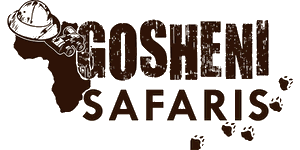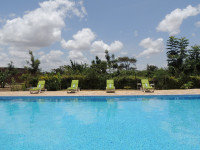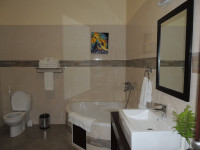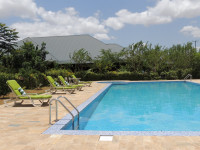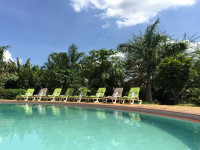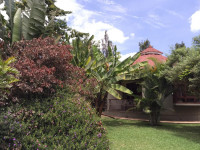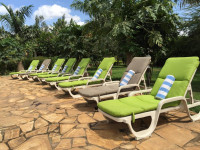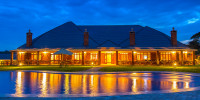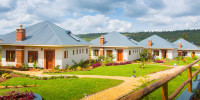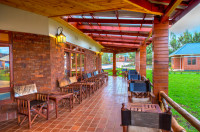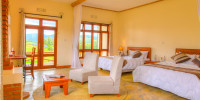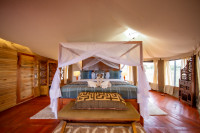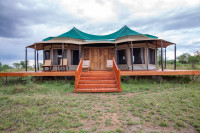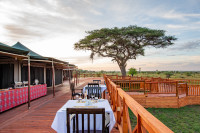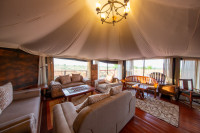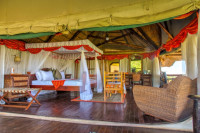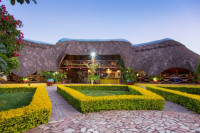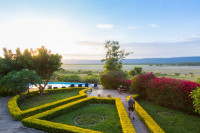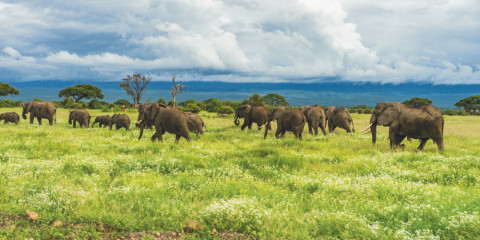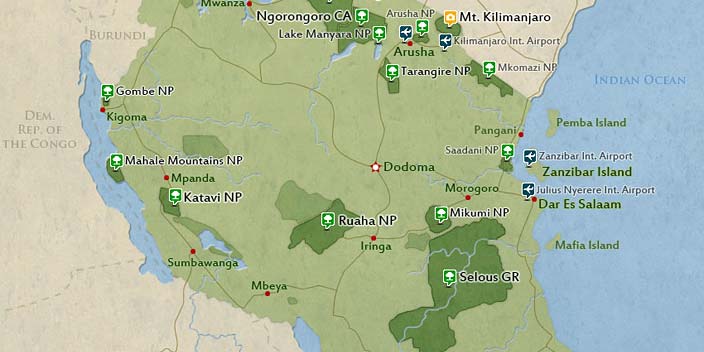
Arrival
Arrival

Day 1
Arrival - Arusha
Arrival - Arusha
Upon arrival at Kilimanjaro International Airport, our official airport team will meet and greet you and assist you with your visa and luggage. You will have some welcoming refreshments and your driver guide will transfer you to the hotel for dinner and overnight.
Arusha is a city in Northern Tanzania and the capital of the Arusha region with a population of 416,442 plus 323,198 in the surrounding Arusha district. It is located below Mount Meru on the eastern edge of the eastern branch of the Great Rift Valley. Arusha has a temperate climate. The city is close to the Serengeti National Park, the Ngorongoro Conservation Area, Lake Manyara National Park, Tarangire National Park, Mount Kilimanjaro, and Arusha National Park on Mount Meru.
- Main Destination:
- Arusha (City)
- Accommodation:
- Airport Planet Lodge
- Meals & Drinks:

Day 2
Londorossi Gate - Mti Mkubwa Camp
Londorossi Gate - Mti Mkubwa Camp
The Lemosho Route departs from the far west side of Mount Kilimanjaro. Getting to Londorossi Gate (2,100 meters) takes approximately 2 hours from Moshi and longer from Arusha. At the gate, you will register with the Kilimanjaro National Park authorities before getting back into the vehicles to be transported to the starting point which is a further 12 kilometers from Londorossi. During the wet season, the track can be very inaccessible to vehicles and you may need to walk the last few miles to the starting point.
Most tour operators provide lunch at this point before starting the short trek to Mti Mkubwa Camp (2,820 meters). Spotting large wildlife like elephant and buffalo is possible on this stretch of the mountain. You will likely be accompanied by an armed guide in case one of the Big Five gets too close for comfort! Dinner will be served when you reach Mti Mkubwa Camp.
- Main Destination:
- Mount Kilimanjaro
- Accommodation:
- Budget camping
- Meals & Drinks:

Day 3
Mti Mkubwa Camp - Shira One Camp
Mti Mkubwa Camp - Shira One Camp
After breakfast at the camp, you start with a gradual hike through the final stretch of the rainforest zone. It then gets steeper as you approach the low alpine moorland zone. The trek is a long one that stops briefly for lunch at Shira One Camp which is on the western edge of the Shira Plateau, just over 8 kilometers from your starting point. The view of Kibo from across the plateau is amazing. Overnight will be at the Shira Camp.
- Main Destination:
- Mount Kilimanjaro
- Accommodation:
- Budget camping
- Meals & Drinks:

Day 4
Shira One - Shira Hut
Shira One - Shira Hut
After breakfast at the camp, we explore the Shira Plateau for a full day. It is a gentle walk east toward Kibo’s glaciated peak, and across the plateau which leads to Shira 2 Camp on moorland meadows by a stream. A variety of walks are available on Lent Hills, making this an excellent acclimatization opportunity. Shira is one of the highest plateaus on earth.
- Main Destination:
- Mount Kilimanjaro
- Accommodation:
- Budget camping
- Meals & Drinks:

Day 5
Shira Hut - Barranco Hut
Shira Hut - Barranco Hut
The landscape is semi-desert from the Shira Plateau. We continue to the east up a ridge, passing the junction toward the peak of Kibo. As we continue, our direction changes to the southeast toward the Lava Tower, also called the "Shark's Tooth." Shortly after the tower, we come to the second junction which brings us up to the Arrow Glacier at an altitude of 16,000 feet. We now continue down to the Barranco Hut at an altitude of 13,000 feet. Here we rest, enjoy dinner, and overnight.
Although you end the day at the same elevation as when you started, this day is very important for acclimatization and will help your body prepare for summit day.
- Main Destination:
- Mount Kilimanjaro
- Accommodation:
- Budget camping
- Meals & Drinks:

Day 6
Barranco Hut - Karanga Hut
Barranco Hut - Karanga Hut
After spending a night at the great Barranco Wall (a very imposing sight at first), you make your way up this awesome-looking obstacle, which in the end normally turns out to be easier than anticipated. Topping out just below the Heim Glacier, you will now appreciate just how beautiful Kilimanjaro really is. The route then heads down through the Karanga Valley over intervening ridges and valleys, and then joins up with the Mweka Route. This is the preferred route down from the summit, so remember it. The last water stop on the route is the Karanga Valley, as there is no water available at Barafu Camp. Enjoy dinner and overnight at the Karanga camp.
- Main Destination:
- Mount Kilimanjaro
- Accommodation:
- Budget camping
- Meals & Drinks:

Day 7
Karanga Valley Camp - Barafu Hut
Karanga Valley Camp - Barafu Hut
Have breakfast at Karanga Camp and then start on your hike. Turn left up the ridge where the route then ascends 640 meters toward Barafu Camp. Barafu is the Swahili word for “ice” and it is a bleak and inhospitable camping area to spend the night. Totally exposed to the ever-present gales, the tents are pitched on a narrow, stony, and dangerous ridge. Make sure that you familiarize yourself with the terrain before dark to avoid any accidents.
The summit is now a further 1,214 meters higher and you will commence with your final ascent attempt on the same night. Prepare your equipment, hiking poles, and thermal clothing. This should include the replacement of your headlamp and camera batteries and make sure you have a spare set available as well. To prevent freezing, it will be wise to carry your water in a thermal flask. Go to bed as early as possible and try to get some precious rest and sleep.
- Main Destination:
- Mount Kilimanjaro
- Accommodation:
- Budget camping
- Meals & Drinks:

Day 8
Uhuru Peak - Mweka Hut
Uhuru Peak - Mweka Hut
You will get up at around 23h20, and after some tea and biscuits, you shuffle off into the night. You will head in a north-westerly direction and ascend through heavy scree toward Stella Point on the crater rim. Here, you will have a well-earned but short rest. Collect the rest of your gear before heading down to Mweka Hut (3,090 meters).
The route is not difficult and will take you down the rock and scree path into the moorland and eventually into the forest. The camp is situated in the upper forest and mist or rain can be expected in the late afternoon. Dinner and water for washing will be prepared.
- Main Destination:
- Mount Kilimanjaro
- Accommodation:
- Budget camping
- Meals & Drinks:

Day 9
Mweka Hut - Arusha
Mweka Hut - Arusha
After an early and well-deserved breakfast, it is a short 4 to 6-hour scenic hike back to the park gate. Some hikers might experience knee problems which could make the descent longer than planned. It is strongly recommended not to pay your porters any tips until you have reached the gate safely with all your gear. Visit the tips page for more information.
At Mweka Gate, you sign your name and details in a register. This is also where successful climbers receive their summit certificates. The climbers who reached Stella Point (5,739 meters) are issued green certificates and those who reached Uhuru Peak (5,895 meters) receive gold certificates.
From Mweka Gate, you will continue down to Mweka village, normally a muddy 3-kilometer (1-hour) hike. In Mweka village, you will be served a delicious hot lunch whereafter you drive back to Arusha for a long overdue hot shower at the lodge.
- Main Destination:
- Mount Kilimanjaro
- Accommodation:
- Arusha Planet Lodge
- Meals & Drinks:

Day 10
Tarangire National Park
Tarangire National Park
After breakfast, you drive to Tarangire National Park for a full-day game drive in the park. Your driver will set and prepare a table for a full, hot lunch (soup, bread rolls, main dish, and fruit salad) followed by a glass of wine, tea, or coffee. In the evening, check in at the lodge or camp for dinner and overnight.
Tarangire National Park is located slightly off the main safari route. It is a lovely, quiet park in Northern Tanzania that is most famous for its elephant migration, birding, and quiet authentic safari atmosphere. The majority of travelers to the region either miss out on Tarangire altogether or venture into the park for only a matter of hours, leaving parts of Tarangire virtually untouched.
- Main Destination:
- Tarangire National Park
- Accommodation:
- Marera Valley Lodge
- Meals & Drinks:

Day 11
Serengeti National Park
Serengeti National Park
After breakfast, we drive to Serengeti to try to catch and view the great migration. In the afternoon, Your driver will set and prepare a table for a full, hot lunch (soup, bread rolls, main dish, and fruit salad) followed by a glass of wine, tea, or coffee. Here, you will meet guests from other companies who are mostly offered a cold sandwich lunch while our services are 5-star on safari. After lunch, go on an afternoon game drive to view the great migration. In the evening, check in at the camp for dinner and overnight.
Serengeti National Park is well known for its healthy stock of resident wildlife, particularly the "Big Five" named for the 5 most prized trophies taken by hunters. The Serengeti is believed to hold the largest population of lions in Africa due in part to the abundance of prey species. More than 3,000 lions live in this ecosystem.
- Main Destination:
- Central Serengeti National Park
- Accommodation:
- Acacia Seronera Luxury Camp
- Meals & Drinks:

Day 12
Serengeti - Ngorongoro Conservation Area
Serengeti - Ngorongoro Conservation Area
After breakfast at the camp, you will have a game drive in Central Serengeti National Park searching for big cats and the Big Five. In the afternoon, your driver will set and prepare a table for a full, hot lunch (soup, bread rolls, main dish, and fruit salad) followed by a glass of wine, tea, or coffee. In the late afternoon, go to the lodge in Ngorongoro for dinner and overnight.
"The only living things which look as if they really belonged to it are the wild animals. Between the animals and Africa, there is an understanding that the human beings have not yet earned" - Laurens van der Post, Venture to the Interior, 1963.
Today, the Serengeti National Park, the Ngorongoro Conservation Area, and the Masai Mara National Reserve across the border in Kenya protect the greatest and most varied collection of terrestrial wildlife on earth. It is one of the last great migratory systems still intact.
- Main Destination:
- Serengeti National Park
- Accommodation:
- Marera Valley Lodge
- Meals & Drinks:

Day 13
Ngorongoro Crater Tour
Ngorongoro Crater Tour
After breakfast at the lodge, go on a game drive in the Ngorongoro Crater for a full-day crater tour. Your driver will set and prepare a table under the car's shade for a full, hot lunch (soup, bread rolls, main dish, and fruit salad) followed by a glass of wine, tea, or coffee. After lunch, proceed with a game drive until the evening when you drive to the camp for dinner and overnight.
The jewel in Ngorongoro's crown is a deep, volcanic crater, the largest unflooded and unbroken caldera in the world. About 20 kilometers across, 600 meters deep, and 300 square kilometers in area, the Ngorongoro Crater is a breathtaking natural wonder. We will visit Lake Magadi, a large but shallow alkaline lake in the southwestern corner which is one of the main features of the crater. A large number of hippos, flamingos, and other waterbirds can usually be seen here.
- Main Destination:
- Ngorongoro Crater
- Accommodation:
- Manyara Wildlife Safari Camp
- Meals & Drinks:

Day 14
Lake Manyara National Park - Arusha - Departure
Lake Manyara National Park - Arusha - Departure
After breakfast at the lodge, go on a morning walking safari in the park, escorted by an armed ranger. Later, go on a game drive in the park until the afternoon. Your driver will set and prepare a table for a full, hot lunch (soup, bread rolls, main dish, and fruit salad) followed by a glass of wine, tea, or coffee. After lunch, continue with the game drive until the late afternoon when you drive back to Arusha for drop-off at the airport.
Manyara provides the perfect introduction to Tanzania’s birdlife. More than 400 species have been recorded, and even a first-time visitor to Africa might reasonably expect to observe 100 of these in one day. Inland of the floodplain, a narrow belt of acacia woodland is the favored haunt of Manyara’s legendary tree-climbing lions and impressively-tusked elephants.
- Main Destination:
- Lake Manyara National Park
- Accommodation:
- No accommodation (End of tour)
- Meals & Drinks:

